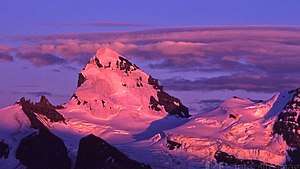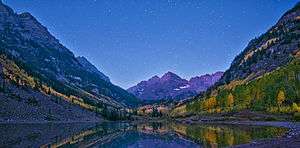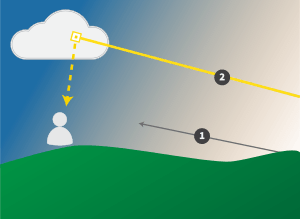Alpenglow
Alpenglow (from German: Alpenglühen, lit. “Alps glow”, Italian: Enrosadira) is an optical phenomenon that appears as a horizontal reddish glow near the horizon opposite to the Sun when the solar disk is just below the horizon. This effect is easily visible when mountains are illuminated, but can also be seen when clouds are lit through backscatter.



Description
Alpenglow is loosely defined and may refer either to indirect sunlight reflected off of clouds after sunset or before sunrise, or to direct sunlight that occurs near sunset or sunrise.
Reflected sunlight
When the Sun is below the horizon, sunlight has no direct path to reach a mountain. Unlike the direct sunlight around sunrise or sunset, the light that causes alpenglow is reflected off airborne precipitation, ice crystals, or particulates in the lower atmosphere. These conditions differentiate between a direct sunlight around sunrise or sunset and alpenglow.[1]
The term is generally confused to be any sunrise or sunset light reflected off the mountains or clouds (see also the "Direct sunlight" section for an alternative view), but true alpenglow is not direct sunlight and is only visible after sunset or before sunrise.[2]
After sunset, if mountains are absent, aerosols in the eastern sky can be illuminated in the same way by the remaining scattered reddish light above the fringe of Earth's shadow. This backscattered light produces a pinkish band opposite of the Sun's direction, called the Belt of Venus.
Direct sunlight
Other sources conflict with the reflected sunlight understanding and define alpenglow as the rosy or reddish light of the setting or rising Sun,[3][4][5] some suggesting that clear skies are necessary (as shown in the photo of Mount Forbes in the lead section).
See also
References
- Cushman, Ruth Carol; Jones, Stephen (December 28, 2009). "Catch Boulder's 'alpenglow' -- blushing mountains -- this winter". Archived from the original on 2018-01-10. Retrieved 2018-01-10.
- "What Is Alpenglow?". Digital Photography School. 2012-11-01. Retrieved 2018-01-10.
- "Lexico, powered by Oxford: 'Alpenglow'". Retrieved 2019-11-15.
- "Merriam-Webster: 'Alpenglow'". Retrieved 2019-11-15.
- "Wicktionary: 'alpenglow'". Retrieved 2019-11-15.
| Wikimedia Commons has media related to Alpenglow. |